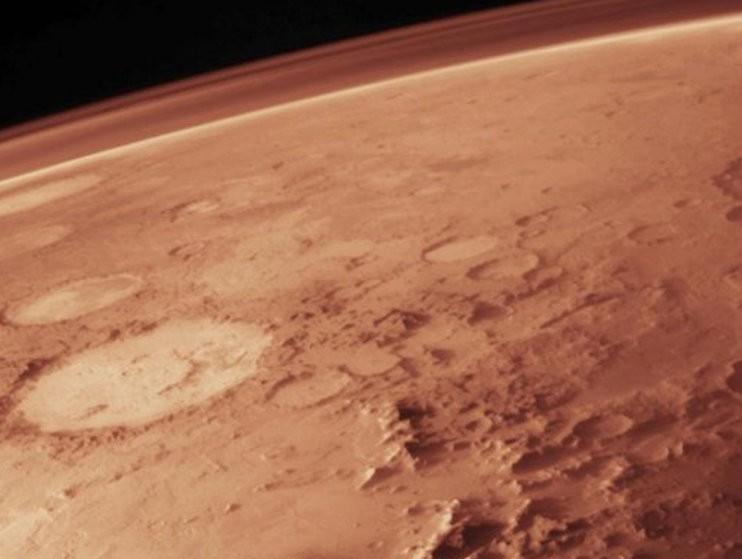Summary: The Martian atmospheric escape has been shown to be due to a loss of magnetic field and an impact of electrons in the solar belt. The solar wind emits ions and electrons that accelerate particles from the Martian atmosphere and escape from the atmosphere under prolonged bombardment.
Mars was a habitable planet in the early days, rather than as arid and desolate as it is now, probably because the Martian atmosphere had dissipated into space long after hundreds of millions of years.

To better explain the disappearance of the Martian atmosphere, scientists began studying currents in the Martian atmosphere, which they believe may have caused the loss of gases in the atmosphere.
A team of researchers used data collected by NASA's Mars Atmosphere and Volatile Evolution Explorer (MAVEN) to draw a current model of the Martian atmosphere for the first time, making what was otherwise confusing and helping scientists find the "real culprit" of atmospheric escape.
Illustration: NASA's Mars Atmosphere and Volatile Evolution Probe (MAVEN), also known as the Marvin probe. Image source: bing
The findings, published Monday in the journal Nature Astronomy, say the constant solar wind is the main reason for the Red Planet's atmospheric escape.
Robin Ramstad, an experimental physicist at the University of Colorado at Boulder and the first author of the new study, wrote in a report: "These currents play an important role in atmospheric loss, transforming Mars from a world that could have nurtured life into a desert with harsh environments." ”
Researchers have tried to explore how much a planet's magnetic field affects its atmosphere.
Illustration: Comparison around the atmosphere of Earth and Mars. Image source: bing
Earth has a magnetic field, but Mars doesn't. The stream of charged particles (i.e., the solar wind) ejected from the Sun's upper atmosphere interacts with the Martian atmosphere, creating an inductive magnetic field, or a region of space around Mars.
The solar wind is emitted by the Sun's upper atmosphere and has a speed of about 1 million km/h.
Illustration: The solar wind strips away the Martian atmosphere at a rate of 100 grams per second. Image source: bing
Scientists now know about the Martian magnetosphere, but they haven't figured out exactly how the magnetosphere affects the Martian atmosphere and how much energy the solar wind actually sends to cause it to escape.
The data shows that the solar wind and magnetic field surround Mars in clusters, and its shape is like spaghetti thrown in mid-air.
Visualization of currents around Mars (From: NASA/Goddard/MAVEN/CU Boulder/SVS/Cindy Starr)
In the course of the second visualization, the scientists used data collected by the Marvin probe to roughly outline the current around Mars, and the images showed that the current originated from the day side of Mars in a cup shape and converged on the pubic side of Mars, connecting the upper atmosphere of Mars and the induced magnetic field caused by the solar wind.
When the ions and electrons of the solar wind hit the "sensing magnetosphere" near Mars, particles of different electrical properties are separated. Some ions move in one direction, and electrons move in the other, creating an electric current that orbits around Mars and leads from the light side to the dark side, creating an overlay current system.
At the same time, X-rays emitted from the Sun and ultraviolet rays constantly ionize the upper atmosphere of Mars, making it conductive.
Ramsda said: "The Martian atmosphere is like a metal ball, acting as a closed circuit. ”
And this process is the main reason for the escape of the Martian atmosphere.
Induced currents convert energy from the solar wind into magnetic and electric fields, accelerating charged particles in the Martian atmosphere, causing the atmosphere to escape.
Images before and after the Martian atmosphere escape (From NASA's Goddard Space Flight Center)
Due to the absence of a magnetic field, Mars' atmosphere has been lost since billions of years ago, and gradually changed from a wet, warm, habitable planet to a cold, dry desert.
In November 2013, the Marvin probe was launched into space to explore mars' atmosphere, climate, and past habitability.
Abstract: In electroelectric reactions with flowing magnetic plasmas (such as the solar wind), the induced magnetosphere conducts the ionospherics of surrounding non-magnetic planetary objects (such as the ionospheres of Mars, Venus, Titan, Pluto, and comets), and the induced current generated makes the ionosphere bind to the deviating plasma. This conclusion brings us to the role of the solar wind in the planet's atmospheric warming, atmospheric escape, and atmospheric evolution.
This similar intrinsic magnetosphere current system on Earth has been mapped out decades ago, and the current system that senses the magnetosphere is mostly unknown. Now, our team used data measured by the Marvin probe for five years to roughly depict the current system of the Martian induction magnetosphere, and unexpectedly found some features of this system, such as the combination of the ionosphere and the bow shock, the symmetry of the current loop in the northern and southern hemispheres, and the distortion of the current path near Mars. Mars' induced magnetosphere current is triggered by a magnetosphere convective electric field and strengthened by the action of the solar wind.
BY: inverse
FY: Brother Bao
If there is any infringement of the relevant content, please contact the author to delete it after the work is published
Please also obtain authorization to reprint, and pay attention to maintaining completeness and indicating source